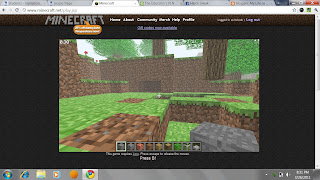Yesterday at Edcampto http://www.edcampto.org/ I had my most interesting conversation about Minecraft yet. A teacher described what happened with Minecraft in his classroom. It was a powerful story.
In his class students built a Minecraft multiplayer server and then spent the entire year building and playing in that world. Their heart and soul went into it. For non-Minecrafters I don't know if you can fully understand what this means, but players will get it. For Minecrafters the world they create is as real as the world they live in. In some ways it is more real because players have a level of power, control and creativity that they do not have in everyday life.
One student played for the entire year but never shared with the rest of the class what he was up to. At the end of the school year they found out. The student had spent the entire year collecting enough dynamite equivalent to the force of the bomb that fell on Hiroshima and then he used it. He blew up their world. It took over 7 minutes and the entire class watched as their creation was destroyed.
I am in shock just hearing it. That day in class ... what was it like?
I am looking for some insight into this part of Minecraft and what happened. Could players comment?
Keep in mind this is an educational blog seen by students.
In his class students built a Minecraft multiplayer server and then spent the entire year building and playing in that world. Their heart and soul went into it. For non-Minecrafters I don't know if you can fully understand what this means, but players will get it. For Minecrafters the world they create is as real as the world they live in. In some ways it is more real because players have a level of power, control and creativity that they do not have in everyday life.
One student played for the entire year but never shared with the rest of the class what he was up to. At the end of the school year they found out. The student had spent the entire year collecting enough dynamite equivalent to the force of the bomb that fell on Hiroshima and then he used it. He blew up their world. It took over 7 minutes and the entire class watched as their creation was destroyed.
I am in shock just hearing it. That day in class ... what was it like?
I am looking for some insight into this part of Minecraft and what happened. Could players comment?
Keep in mind this is an educational blog seen by students.






